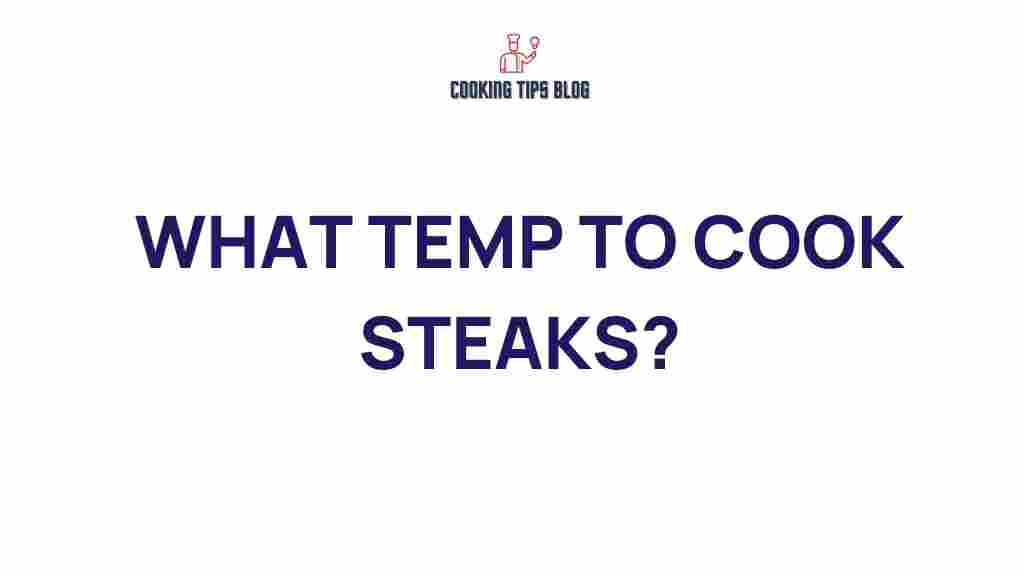Unlocking the Perfect Steak: What Temperature Should You Cook It At?
Cooking the perfect steak is both an art and a science. One of the most critical factors in achieving that juicy, tender bite is understanding the steak cooking temperature. Whether you prefer your steak rare, medium, or well-done, knowing the right temperatures will help you achieve the desired doneness every time. In this article, we’ll explore the ideal cooking temperatures for steak, how to measure them accurately, and some tips to troubleshoot common issues.
Why Cooking Temperature Matters
The steak cooking temperature directly influences the texture, flavor, and overall eating experience of your steak. Cooking at the right temperature ensures that the proteins break down correctly, allowing for a tender and flavorful meal. Here are the main reasons why you should pay attention to cooking temperatures:
- Flavor Development: Different temperatures promote the Maillard reaction, which enhances flavor.
- Texture: Cooking steak at the right temperature helps maintain its juiciness and tenderness.
- Food Safety: Ensuring that your steak reaches the appropriate internal temperature can prevent foodborne illnesses.
Understanding Steak Doneness Levels
Before diving into the specific steak cooking temperature guidelines, it’s essential to understand the various levels of doneness:
- Rare: 120-125°F (49-52°C) – Cool red center
- Medium Rare: 130-135°F (54-57°C) – Warm red center
- Medium: 140-145°F (60-63°C) – Warm pink center
- Medium Well: 150-155°F (65-68°C) – Slightly pink center
- Well Done: 160°F and above (71°C and above) – No pink, very firm
How to Measure Steak Cooking Temperature
To achieve the perfect steak, you’ll need a reliable method to measure the steak cooking temperature. Here’s how:
- Use a Meat Thermometer: The most accurate way to check the internal temperature of your steak is by using a digital meat thermometer. Insert it into the thickest part of the steak, avoiding any bone or fat.
- Check the Color: While not as reliable as a thermometer, you can also assess doneness by cutting the steak and checking the color of the meat.
- Touch Test: With practice, you can use the touch test to gauge doneness. A rare steak feels soft, while well-done feels firm.
Step-by-Step Process for Cooking Steak
Here’s a simple guide to cooking the perfect steak with the right steak cooking temperature:
1. Choose Your Steak
Select a high-quality cut of steak. Ribeye, filet mignon, and sirloin are popular options.
2. Prepare Your Steak
Remove the steak from the refrigerator and let it sit at room temperature for about 30 minutes before cooking. Season it with salt and pepper or your favorite marinade.
3. Preheat Your Cooking Surface
Whether you’re using a grill, stovetop, or oven, make sure it’s preheated. Aim for high heat for a good sear.
4. Cooking the Steak
Place your steak on the hot surface and follow these guidelines based on your preferred doneness:
- Rare: Cook for about 2-3 minutes per side.
- Medium Rare: Cook for about 3-4 minutes per side.
- Medium: Cook for about 4-5 minutes per side.
- Medium Well: Cook for about 5-6 minutes per side.
- Well Done: Cook for about 6-7 minutes per side.
5. Check the Internal Temperature
Use your meat thermometer to check the internal temperature. Make sure to remove the steak from heat when it’s 5°F below your target temperature, as it will continue to cook while resting.
6. Let It Rest
After cooking, let the steak rest for about 5-10 minutes. This allows the juices to redistribute, resulting in a more flavorful and tender steak.
Troubleshooting Common Issues
Even with the best intentions, things can sometimes go wrong. Here are some troubleshooting tips for common steak cooking issues:
- Steak Is Too Tough: This may result from overcooking or using a lower-quality cut. Always use high-quality meat and monitor steak cooking temperature closely.
- Steak Is Overcooked: If your steak turns out to be well-done when you wanted it rare, make sure to use a meat thermometer to avoid guessing.
- Steak Is Dry: This can happen if you cook it at too high a temperature for too long. Keep the heat high for searing, but lower it to finish cooking.
Conclusion
Cooking the perfect steak is achievable with a little knowledge and practice. Understanding steak cooking temperature is crucial for ensuring your steak is cooked to your liking while maintaining its flavor and tenderness. By following the steps outlined in this article, you’ll be well on your way to impressing your friends and family with restaurant-quality steaks at home.
For more tips on cooking techniques, check out our article on Mastering the Art of Grilling and explore the world of flavors that await you. Happy cooking!
For additional resources on safe cooking temperatures, visit the USDA’s website here.
This article is in the category Recipes and created by Cookingtipsblog Team
